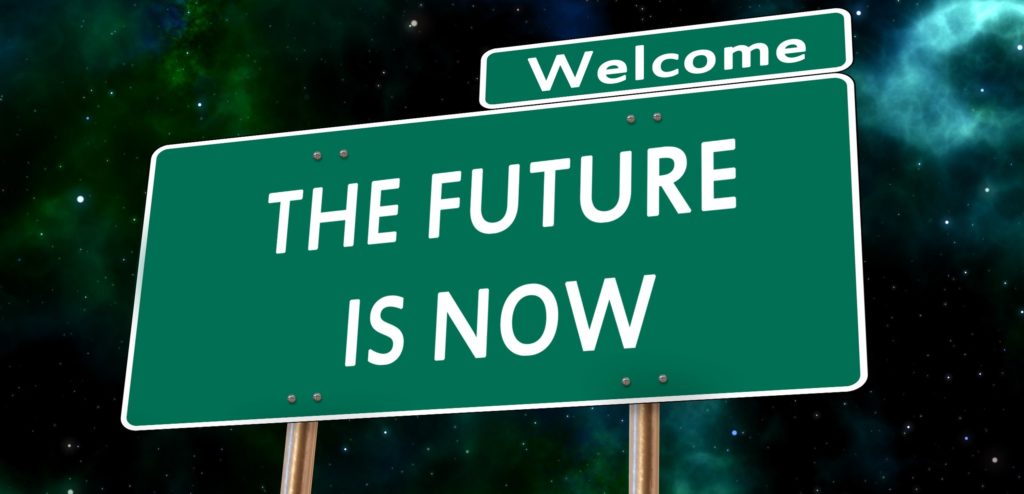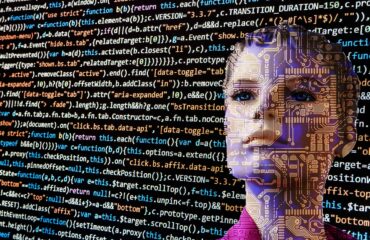Image by Gerd Altman, Pixabay
By James Myers
Humanity has always faced technological choices, whether the technology has been manual, mechanical, or electronic. As physicist, humanist, and Holocaust survivor Ursula Franklin (1921-2016) broadly defined the word, technology is “the way we do things,” and humans have always done things. But with our technology now so powerful to create or destroy, choosing our way of doing things has never been more important.
The future hangs in the balance.
How do you imagine the future unfolding with various types of technology either now in use or under development? When you weigh the potential future benefits and risks of a particular technology, where would you place it on a scale from good to bad? If you could choose which technologies should be developed and which should be changed, how would you choose?

Ursula Franklin (1921-2016)
Choosing holistic or prescriptive technology
Ursula Franklin was featured in the first edition of The Quantum Record. In her 1989 Massey Lecture, later published as The Real World of Technology, she stated that our technological choices are fundamentally either holistic or prescriptive.
Holistic technologies adapt to and address the needs of their human users and tend to be peaceful.
A holistic technology preserves human craft and creativity, allowing the human user to make choices in the application and extent of the technology in different situations. Holistic technology has what Franklin called “reciprocity”, enabling users to adjust the original assumptions on which the technology is based. Word processing software is an example of a holistic technology that does not tell its user what or how to write; the writer has discretion at all times with the written content while the technology speeds the process.
Prescriptive technologies provide little or no ability to adjust to the needs and preferences of human users.
Humans must adapt to the requirements of these technologies, and conflict often arises when the interests of those who control the technology differ from the interests of its users. There is limited or no reciprocity in prescriptive technologies. The technologies now used in manufacturing assembly lines and distribution warehouses of businesses like Amazon are prescriptive; they establish processes that the human user has little or no power to adjust in varying situations.
“While we should not forget that prescriptive technologies are often exceedingly effective and efficient, they come with an enormous social mortgage. The mortgage means that we live in a culture of compliance, that we are ever more conditioned to accept orthodoxy as normal, and to accept that there is only one way of doing ‘it’.” – Ursula Franklin
Holistic and prescriptive technologies have existed since technology began with the earliest human inventors and users.
An example of an ancient holistic technology is the clay tablet and stylus used for cuneiform writing, which provided for a flourishing of communication thousands of years ago. An early example of prescriptive technology, which Ursula Franklin studied, was used in the bronze-casting industry in China a thousand years ago. It required some labourers to obtain the metal, some to melt the metal, and some to put the metal in the molds, and at no point were the labourers able to apply their own decisions or deviate from the process that had been prescribed for them and enforced by their managers.
Will the future be holistic or prescriptive?
We face some stark choices with our powerful technology. Do we believe in the future potential of holistic technology, or do we accept the limits of the prescriptive types? Franklin observed that technological choices reflect our way of thinking – or mindset – about reality and our own potential and role in the course of time. What is our mindset on technology?
See the sidebar, “Technology and Our Perception of Reality.” ☞
What is our view of the future, as evidenced in the technology we are now developing? Do we have a positive view of our own human role in the future, with faith in our creativity and realization that combining our minds in a common purpose can yield tremendous benefits in time? Or do we fear human actions and intentions in the future so that we must develop a means of controlling real and imagined enemies before they control us?
This edition of The Quantum Record contains news of both types of holistic and prescriptive technology.
Computing and internet technology have fuelled citizen science, an example of a holistic application that extends the capabilities and interests of humans to learn and discover at their own pace with significant benefits to society. To the extent that GPT-3 technology, which replicates human speech and writing, seeks to replace human skill and craft it does not appear to be holistic and could become prescriptive if it introduces logical challenges to our perception of reality. Brain-computer interface technology could turn out to be holistic, if the brain is always able to control the computer, but if it turns out that control is with the computer then it would become prescriptive. Developing technology to give sight to robots is another example of an application that could be either prescriptive or holistic, depending on human ability to control its uses.
The Quantum Record is interested in your views on specific examples of technology now in use or in development that could wind up being holistic or prescriptive. As we continue to publish news of technologies that might be either, we will soon introduce a poll to ask how you see the future unfolding and rate the probability of either outcome in time.

Image by 0fjd125gk87 on Pixabay
Defining the many paths to the future
It’s a necessary limitation of any moment in the present that we can choose to take only one of many possible paths to the future. Some of the paths we might choose could turn out to be much shorter than others. We have no way of knowing for certain, but we can certainly use our reason to balance the probabilities.
It’s now a question of time – how greatly or how little do we value the future? Do we want our technology to prescribe the future for us, or do we want a future that is defined by humans?
Are we confident in our human ability and creativity to imagine a bright and peaceful future, or do we see inevitable war and destruction in an eternal struggle to maintain and amplify our differences?
Some of our technological paths could lead to planetary destruction. The news headlines are full of warnings about such paths – for example if we choose the development and proliferation of atomic, hypersonic and space-based weapons, or allow the capacity of cyber warfare to advance beyond any means to control. Is destruction on such paths inevitable? In assigning probabilities, we should be realistic about the wars already raging in Europe and elsewhere on this planet and about the increasingly irreconcilable differences among citizens, their leaders, and nations. A wise person, under such circumstances, would not bet heavily on a peaceful ending to some of the paths we find ourselves on.
The question is one of mindset.
Other paths, however, could lead to very bright futures. Those are the paths on which the combined knowledge and goodwill of nearly 8 billion humans are applied with such creativity and foresight as to put the power of the universe to peaceful purposes. If we were to head in such a direction, there is no reason to believe that so many minds could not figure out a way to harness the power of today’s technology to end hunger, end pollution, end the scarcity of energy supplies, end disease, and end war. There would be no need for war, on such paths.
What’s stopping us from choosing the path to a bright future, other than our own mindsets? If we look at ourselves hard in a mirror, reflecting on what we could be instead of what we are, do we like what we see? If not, then change it.
It’s easy to change a mindset. All that’s required is to free the mind from its present limits and allow it to sense the infinite probabilities of the future.

Image by nugroho dwi hartawan on Pixabay
Technology and Our Perception of Reality
Ursula Franklin’s Real World of Technology described four levels of reality that we can perceive. Technology delivers the second, third, and fourth types – each of which is further removed from our everyday experience and can be increasingly subject to manipulation and falsehood.
- Vernacular: The base level of reality is shaped by the present circumstances of the individual without external influence, what Ursula called everyday “nitty-gritty” reality involving activities necessary for living such as eating, housing, and grooming.
- Extended: This is the second level of reality based on the experiences of others. For example, you may not have experienced war firsthand but by reading the descriptions of war by its survivors (like Franklin) your reality can extend to situations not personally encountered.
- Constructed, or reconstructed: The third level of reality does not represent anyone’s actual experience but is an archetype – a conceptual model. Examples of constructed or reconstructed reality include fiction, advertising, and propaganda with situations that may or may not appeal to the recipient by analogy.
- Projected: The final level of reality is the projected future of the first level, the vernacular reality of the present, incorporating extended and constructed realities.
Technological Cycles: From Creativity to Complacency
Franklin highlighted five stages of the invention, development, and proliferation of a particular technology. There is an initial burst of creativity which is followed by discovery of new applications, then proliferation, and eventually complacency.
- Invention: Often accompanied by enthusiasm for the imagined possibilities when few if any of the practical applications have been developed.
- Growth: As each practical application is developed, new direct or indirect applications are discovered and the technology spreads in its utility.
- Acceptance: As cost is reduced and other barriers to use are eliminated, more people adopt its processes and the technology becomes widely accepted as a ‘normal’ way of doing things.
- Standardization: Typically when adopted for large-scale and widespread use, the potential for individual control is reduced and the technological features become standardized and variables eliminated when the production is industrialized and optimized for profit and efficiency. People begin to use the technology in the same way regardless of where they are located or differences in their particular needs.
- Stagnation: Standardization tends to lead to complacency as users fall into accepted patterns of usage without considering alternatives, and the technology fails to adapt to emerging needs for which it was not originally contemplated.




